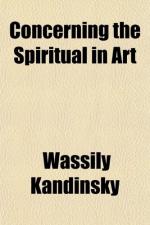This world is too far above us for its harmony to touch our souls. A great silence, like an impenetrable wall, shrouds its life from our understanding. White, therefore, has this harmony of silence, which works upon us negatively, like many pauses in music that break temporarily the melody. It is not a dead silence, but one pregnant with possibilities. White has the appeal of the nothingness that is before birth, of the world in the ice age.
A totally dead silence, on the other hand, a silence with no possibilities, has the inner harmony of black. In music it is represented by one of those profound and final pauses, after which any continuation of the melody seems the dawn of another world. Black is something burnt out, like the ashes of a funeral pyre, something motionless like a corpse. The silence of black is the silence of death. Outwardly black is the colour with least harmony of all, a kind of neutral background against which the minutest shades of other colours stand clearly forward. It differs from white in this also, for with white nearly every colour is in discord, or even mute altogether.
[Footnote: E.g. vermilion rings dull and muddy against white, but against black with clear strength. Light yellow against white is weak, against black pure and brilliant.]
Not without reason is white taken as symbolizing joy and spotless purity, and black grief and death. A blend of black and white produces gray which, as has been said, is silent and motionless, being composed of two inactive colours, its restfulness having none of the potential activity of green. A similar gray is produced by a mixture of green and red, a spiritual blend of passivity and glowing warmth.
[Footnote: Gray = immobility and rest. Delacroix sought to express rest by a mixture of green and red (cf. Signac, sup. cit.).]
The unbounded warmth of red has not the irresponsible appeal of yellow, but rings inwardly with a determined and powerful intensity It glows in itself, maturely, and does not distribute its vigour aimlessly (see Fig. 2).
The varied powers of red are very striking. By a skillful use of it in its different shades, its fundamental tone may be made warm or cold.
[Footnote: Of course every colour can be to some extent varied between warm and cold, but no colour has so extensive a scale of varieties as red.]
Light warm red has a certain similarity to medium yellow, alike in texture and appeal, and gives a feeling of strength, vigour, determination, triumph. In music, it is a sound of trumpets, strong, harsh, and ringing.
Vermilion is a red with a feeling of sharpness, like glowing steel which can be cooled by water. Vermilion is quenched by blue, for it can support no mixture with a cold colour. More accurately speaking, such a mixture produces what is called a dirty colour, scorned by painters of today. But “dirt” as a material object has its own inner appeal, and therefore to avoid it in painting, is as unjust and narrow as was the cry of yesterday for pure colour. At the call of the inner need that which is outwardly foul may be inwardly pure, and vice versa.




